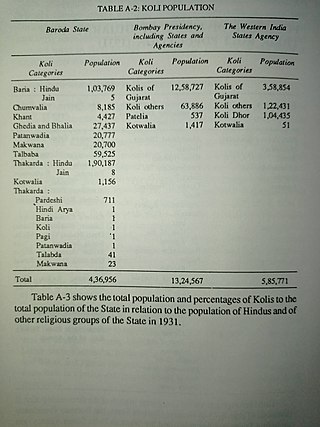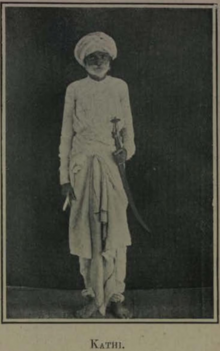
Kathiawar is a peninsula, near the far north of India's west coast, of about 61,000 km2 (23,500 sq mi) bordering the Arabian Sea. It is bounded by the Gulf of Kutch in the northwest and by the Gulf of Khambhat in the east. In the northeast, it is connected to the rest of Gujarat and borders on the low, fertile hinterland of Ahmedabad. It is crossed by two belts of hill country and is drained radially by nine rivers which have little natural flow aside from in monsoon months, thus dams have been built on some of these. Kathiawar ports have been flourishing centres of trade and commerce since at least the 16th century.

Saurashtra, also known as Kathiawar, is a peninsular region of Gujarat, India, located on the Arabian Sea coast. It covers about a third of Gujarat state, notably 11 districts of Gujarat, including Rajkot District. It was formerly a state of India before it merged with Bombay state. In 1961 it separated from Bombay and joined Gujarat.

Jadeja is a Samma Rajput clan that inhabits the Indian state of Gujarat and the Tharparkar district of Sindh, Pakistan. They originated from Sammas of Sindh, a pastoral group, and laid a claim on the Rajput identity after marriages with Sodha Rajput women by adopting a process called Rajputisation.
Jethwa is a clan of Rajputs and Koli castes of Gujarat. Jethwa surname is also found among Darji, Mistris of Kutch, and Gurjar Kshatriya Kadias castes of Gujarat.

Vachharadada or Vachhrajdada is a Hindu deity from Gujarat in India. He is an eminent warrior-hero of the region. Hindus honor him as a deity.

Charan is a caste in South Asia natively residing in the Rajasthan and Gujarat states of India, as well as the Sindh and Balochistan provinces of Pakistan. Historically, Charans have been engaged in diverse occupations like bards, poets, historians, pastoralists, agriculturalists and also administrators, jagirdars and warriors and some even as traders.

The Pateliya, or Patelia or Patel is a landowning Subcaste of Koli caste found in the Indian states of Gujarat. During the British Raj in India, Patelia Kolis served as tax collectors and administrators. The name Patelia comes from a word meaning village chief. Many Patelia Kolis also went into business and commerce during the Raj period. Patelia Kolis are part of Talapada Kolis of Gujarat.
The Vala, or Wala is a Gujarati clan (Gotra) mostly found among Koli, Rajput and Kathi castes of Gujarat.

Mer, Maher or Mehar is a caste from the Saurashtra region of Gujarat in India. They are largely based in the Porbandar district, comprising the low-lying, wetland Ghēḍ and highland Barḍā areas, and they speak a dialect of the Gujarati language. The Mers of the Ghēḍ and Barḍā form two groups of the jāti and together they are the main cultivators in the Porbandar District. Historically, the men served the Porbandar State as a feudal militia, led by Mer leaders. In the 1881 Gazette of the Bombay Presidency, the Mers were recorded numbering at 23,850. The 1951 Indian Census recorded 50,000 Mers. As of 1980 there were estimated to be around 250,000 Mers.
Vala State or Vallabhipura was a non-salute princely state in India during the British Raj until 1948. The centre was the city of Vallabhi. The last ruler of the state signed the state's accession to the Indian Union on 15 February 1948.

The Chaulukya dynasty, also Solanki dynasty, was a dynasty that ruled the Kingdom of Gujarat in western India, between c. 940 CE and c. 1244 CE. Their capital was located at Anahilavada. At times, their rule extended to the Malwa region in present-day Madhya Pradesh. The family is also known as the "Solanki dynasty" in the vernacular literature. They belonged to the Solanki clan of Rajputs.
The Chudasama dynasty, a Samma branch, ruled parts of the present-day Saurashtra region of Gujarat state in India between the 9th and 15th centuries. The origin of the Chudasama to Chudachandra Yadav, a Rajput of the Sama tribe. The ruling dynasty was, therefore called Chudasama Their capital was based in Junagadh and Vamanasthali.
Jamka is a village and former Rajput non-salute princely state on Saurashtra peninsula, in Gujarat, western India.
Jalia Devani is a former Rajput non-salute princely state on Saurashtra peninsula, in Gujarat, western India.

Limda or Hanubha na Limda, literally Hanubha's Limda, is a former Rajput talukdari in Gohilwar prant of Saurashtra peninsula in the Indian state of Gujarat. It was held by the Gohil Rajputs clan. Its pre-Independence ruler held the title of Darbar Saheb.
Jethwa dynasty was a dynasty that ruled over present day Gujarat region of India from 7th century AD till middle of 20th century, when India became independent. It was a Rajput dynasty ruled by Jethwa clan of Rajputs.
The Gohil dynasty or Gohil or Guhilas of Saurashtra ruled parts of Saurashtra region of present-day Gujarat state of India as subordinates or independents starting 12th century. Their origin is traced to Guhila dynasty of Gujarat and they had migrated to Saurashtra in 12th century. The earliest known inscription of Gohils is found from Mangrol. They later moved to the east coast where they established themselves and the region came to be known as Gohilwar and ruled till the independence of India in 1947. The erstwhile princely states of Bhavnagar, Palitana, Lathi, Vala and Rajpipla belonged to Gohil rulers.
Sodha is a Rajput clan residing in India and Pakistan.
Harald Tambs-Lyche is a Norwegian ethnologist and social anthropologist.
The Rajputs in Gujarat, or Gujarati Rajputs are members of the Rajput community living in the western Indian state of Gujarat. They ruled several dynasties and princely states during the British era. Some Rajput clans of Gujarat have origins from outside regions such as Rajasthan, while others are native to the region.









